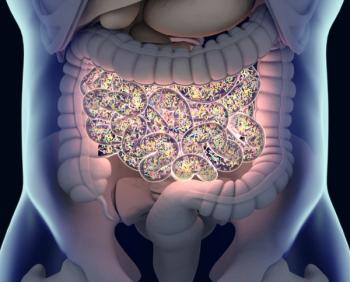
- ONCOLOGY Vol 15 No 1
- Volume 15
- Issue 1
Capecitabine in Colorectal Cancer
Capecitabine (Xeloda) is the first orally available fluoropyrimidine approved for use in patients with cancer. It was initially approved for use in metastatic breast cancer, but significant data also support its use in the management
ABSTRACT: Capecitabine (Xeloda) is the first orally availablefluoropyrimidine approved for use in patients with cancer. It was initiallyapproved for use in metastatic breast cancer, but significant data also supportits use in the management of metastatic colorectal cancer. Capecitabine relieson a series of metabolic steps, the last of which occurs primarily within cancercells. This results in selective activation of the compound within cancer cells,thereby reducing systemic toxicities and allowing for greater dose intensity.This article reviews selected phase I, phase II, and phase III clinical trialsconducted in patients with colorectal cancer that document the metabolicactivation of this compound and support its use in patients with advancedcolorectal cancer. [ONCOLOGY 15(Suppl 2):41-47, 2001]
Introduction
Fluorouracil (5-FU) has been the mainstayof treatment for colorectal cancer in the US for the past 40 years, primarilybecause no other agents with significant activity in colorectal cancer have beenavailable. As a result, researchers focused on optimizing 5-FU therapy with twomain strategies. The first was to add agents to 5-FU in a logical,biologically-based fashion that generates an enhanced anticancer response.Agents tested include leucovorin,[1] methotrexate (Folex, Mexate),[2,3]trimetrexate (Neutrexin),[4] PALA (Sparfosate sodium),[5] IUdR,[6] AZT,[7]interferon,[8] and many others. This strategy of biochemical modulationsucceeded in generating improvements in response rates over single-agent5-FU.[9]
The second major avenue of research altered the treatmentschedule for 5-FU. Traditionally, 5-FU was administered as a bolus infusion and,consequently, was associated with a distinctive efficacy and side effectprofile. However, when 5-FU is infused over a prolonged period, an alternateefficacy and toxicity profile emerges.[10] An extreme example of this strategyis the use of chronomodulated infusional 5-FU in an attempt to take advantage ofdiurnal variations in the metabolism of this agent.[11]
Bolus vs Prolonged Studies
Multiple studies, including meta-analyses, have been performedcomparing bolus schedules of 5-FU with prolonged infusion schedules in coloncancer patients.[12,13] The evidence suggests that infusional schedules are lesstoxic, have higher response rates, and improve survival, compared with bolusschedules (Table 1). Major reasons for the lack of widespread use of continuousinfusion 5-FU center around the inconvenience of prolonged infusion therapiesand enhanced physician and patient care demands. The development of an orallybioavailable compound may circumvent these problems and lead to superior therapyfor patients with colon cancer.
Because it is rapidly and inconsistently metabolized bydihydropyrimidine dehydrogenase (DPD), it is not feasible to use 5-FU orally.Several approaches have been pursued in an attempt to bypass DPD metabolism andcreate an orally bioavailable compound. One approach involves the use of agentsthat inhibit or compete directly with DPD and, in a sense, "level theplaying field" so that 5-FU becomes orally bioavailable.[14,15]
The agent capecitabine (Xeloda) approaches this problem in adifferent way. This compound was designed to be resistant to DPD metabolism inits native form. However, through a series of enzymatic steps within the bodyand a final step within tumor cells, capecitabine is metabolized to become5-FU.[16] Essentially, it is selectively activated within tumors as 5-FU,resulting in reduced systemic exposure and toxicity while maintaining highconcentrations of intratumoral 5-FU.
There is considerable interest and debate surrounding thehistory of these oral 5-FU agents, and in this article, I will review thedevelopment and clinical experience of capecitabine in colorectal cancer. Thesuccessful evolution of these compounds has resulted in a more convenient methodof administering 5-FU, a lower toxicity profile, and a significantly higherresponse rate in patients with metastatic colon cancer when compared to IV 5-FU.
Phase I ExperienceWith Capecitabine
Three phase I trials of single-agent capecitabine using threedifferent treatment schedules were performed in patients with a variety ofmalignant tumors. One involved prolonged continuous exposure using twice-dailydosing without interruptions.[17] A second used capecitabine alone in a2-week-on and 1-week-off schedule.[18] The third used a similar intermittentschedule, but with the addition of leucovorin.[19] These studies found that theintermittent schedules allowed administration of higher doses of capecitabinebut resulted in greater hand-foot syndrome. Diarrhea was reported as thedose-limiting toxicity in all treatment schedules.
An early clinical trial was performed in patients with coloncancer to prove that (1) the key activating enzyme, thymidine phosphorylase(TP), is indeed overexpressed within tumors as compared to normal tissues, and(2) that capecitabine is selectively activated within tumors resulting in higher5-FU concentrations.[20] The study was designed to treat patients who werescheduled to undergo resection of either their primary colon cancer or ametastasis with a preoperative course of capecitabine 2500 mg/m2 split into twodaily doses for 5 to 7 days. Resections were performed within 12 hours afteradministration of the last dose.
Phase I Results
The resected specimens were then analyzed for levels of TP and5-FU. Comparisons were made between tumor, and surrounding normal tissue, andplasma. The results strongly support the theory that capecitabine is selectivelyactivated within tumors. First, tumor tissues markedly overexpress TP whencompared to normal tissues (with the exception of normal liver, which alsoexpress high levels of TP). In an exact parallel, 5-FU levels were markedlyhigher in tumors compared to surrounding tissue and plasma, and again, the liverwas the exception with fairly high levels of 5-FU. In fact, when theconcentrations of 5-FU in tumor were compared to those within the plasma, atwenty-fold increase in 5-FU was found within tumors (Figure1).
These data have been compared to similar analyses of IV 5-FU,which demonstrated that, following intravenous administration of 5-FU in coloncancer patients, there are higher concentrations of 5-FU in circulating plasmathan in the tumor.[21] Therefore, this study strongly supported the importanceof mechanisms of selective activation and increased delivery of 5-FU to thetumor.
Phase II Trial of Capecitabine in Colon Cancer
As reviewed above, several schedules emerged from the phase Itrials, each having advantages and disadvantages. In order to define the optimumschedule to carry forward into more definitive phase III trials, a randomizedphase II trial was performed comparing the three leading schedules ofcapecitabine in colorectal cancer.[22] A summary of the trial design is shown inFigure 2. This trial was performed in patients with metastatic colon cancer whohad received no previous therapy. Patients were randomized to one of threeschedules of capecitabine. The end points of the trial were response rates andtoxicity, and an analysis for dose intensity was also performed.
Results demonstrated no difference in survival among the threetreatment arms. However, there was significant improvement in time to diseaseprogression in the patients who received capecitabine alone on an intermittentschedule as seen in Table 2. As predicted, the higher dose, intermittentschedules resulted in greater toxicity, particularly diarrhea and hand-footsyndrome, when compared with the lower-dose continuous infusion schedule. Theintermittent schedule without leucovorin was selected for the phase IIIrandomized trials based on the improved time to disease progression, the higherdose intensity, and the better therapeutic index associated with that regimen.
Phase III Trials of Capecitabine in Colorectal Cancer
Two phase III trials were conducted comparing capecitabine tointravenously administered 5-FU and leucovorin in patients with previouslyuntreated metastatic colorectal cancer. One trial was performed primarily inEurope[23] and the other, primarily in North America.[24] The design of thetrials was identical and each was powered to show equivalence in overallresponse rate between capecitabine and IV 5-FU/leucovorin. Secondary objectivesincluded a comparison of the toxicity, time to disease progression, overallsurvival, time to response, quality of life, and duration of response.
At the time the trials were designed, the standard of care forfront-line treatment of metastatic colon cancer was the Mayo Clinic schedule of5-FU and leucovorin5-FU 425 mg/m2 plus leucovorin 20mg/m2 administeredintravenously for 5 days every 28 days. This regimen was therefore selected asthe control arm for both of these studies. The standard criteria for phase IIIrandomized trials in this disease population established eligibility for thesestudies. Tumor responses were analyzed by the investigators and by anindependent group of radiologists, who were blinded. Tumor assessment was basedon WHO criteria.
Phase III Trial Performedin Europe, Taiwan, Australia,and Israel
The demographics for this trial are summarized in Table3. Bothtrial arms were evenly matched for all characteristics. Patients receivingcapecitabine in this trial achieved an overall response rate of 26.6% comparedto 17.9% for those receiving the Mayo Clinic 5-FU/leucovorin regimen (P =0.013). However, when these responses were reviewed by an independent reviewcommittee, statistical significance was absent: the response rate for thecapecitabine arm was 18.9% and 15% for those on the 5-FU/leucovorin arm. Whilethere is a trend towards benefit in survival and time to progression with theuse of capecitabine, it did not attain statistical significance.
Hand-foot syndrome was more common in patients treated withcapecitabine, but mucositis and stomatitis were more common in the5-FU/leucovorin regimen. Life-threatening grade 3/4 toxicities were less commonin the capecitabine arm. Most prominent was the absence of fever/neutropenia inpatients treated with capecitabine. Time to onset of the first grade 3/4 adverseevents was more rapid with IV 5-FU/leucovorin than with capecitabine.
Significant differences in laboratory studies were seen betweenthe two treatment arms with regard to myelosuppression and hyperbilirubinemia. Asignificantly greater number of episodes of grade 3/4 myelosuppression occurredin the IV 5-FU/leucovorin regimen, whereas increases in total bilirubin wereseen in 23% of patients receiving capecitabine compared to 3% of IV5-FU/leucovorin regimen patients. The elevation of bilirubin is similar to thatseen with infusional 5-FU but the exact mechanism of this is unclear. Thehyperbilirubinemia was mild and reversible.
This trial demonstrated a superior response rate withcapecitabine; however, statistical significance was absent upon independentreview. It also showed a time to disease progression and an overall survivalrate equivalent to IV 5-FU. The use of capecitabine was associated with lowertoxicity, including less neutropenia and stomatitis, but with a greaterincidence of hand-foot syndrome.[23]
Phase III Trial in United States, Canada, Mexico, and Brazil
This trial was identical in design to the European trial.Eligibility and the treatment schedules were the same. A summary of thedemographics is listed in Table 4. The arms were well balanced with a slightlygreater number of patients who received prior adjuvant 5-FU in the IV 5-FU/leucovorin arm. The response rates reported in this study were 24.8% for thecapecitabine arm and 15.5% for the IV 5-FU/leucovorin arm (P = .005). When theseresults were reviewed by the independent review committee, statisticalsignificance was maintained and, in fact, improved with a response rate of 25.8%for the capecitabine arm and 11.6% for the 5-FU/leucovorin arm (P = .0001).However, there still was no difference in time to disease progression or overallsurvival between the two treatment arms.
The toxicity profile was similar to the European study with agreater degree of hand-foot syndrome observed in the capecitabine treatment armand greater stomatitis observed in the 5-FU/leucovorin arm. Similar results wereseen with regard to fever/neutropenia; however, the incidence was greater in the5-FU/leucovorin arm. The time to onset of the first grade 3/4 adverse events wasmore rapid in the 5-FU/leucovorin arm, but elevations of bilirubin occurred morerapidly in the capecitabine arm.
The results of the study showed an improvement in response ratethat was statistically significant but did not translate into a survivalbenefit. However, time to disease progression was equivalent between treatmentarms and overall survival was similar. There was no difference in overallquality of life or global health status. Capecitabine was safe, resulting infewer grade 3/4 toxicities compared with IV 5-FU/leucovorin.[24]
When data from the two clinical trials were pooled and analyzed,a statistically significant improvement in the overall response rate wasobserved by both the investigators and the independent review committee;however, there was no survival benefit as shown in Figure3. Responses weregreater with capecitabine regardless of tumor characteristics, such as tumorlocation, and prior treatment with adjuvant chemotherapy.
Significant dose reductions were implemented in the treatmentarms of both studies: 42% of patients in the 5-FU/leucovorin arm required dosereductions and 33% in the capecitabine arm. Typically, dose reductions were madelater with capecitabine, supporting the evidence that toxicities are not oftenseen on the first cycle of treatment but tend to occur during cycles 2 and 3.However, with the Mayo Clinic 5-FU /leucovorin regimen, toxicities are oftenobserved during cycle 1. These data suggest that the doses used in both arms ofthis trial may be too high; in future studies, either lower doses or alternativeschedules should be considered.
Future Trials
Combinations
The development of capecitabine as a single agent in colorectalcancer has moved forward in an efficient and focused manner. Current researchfocuses on combination therapy with capecitabine and other activechemotherapeutic agents, such as CPT 11 and oxaliplatin. A series of phase I andII trials are underway to explore various combinations. It is hoped that thelower toxicity profile and improved response rates seen with capecitabine willtranslate into a more effective and less toxic combination therapy.
Adjuvant Therapy
Plans are underway for studies of capecitabine as adjuvanttherapy of colorectal cancer (X-ACT study). However, there is concern about theuse of capecitabine in the adjuvant setting because the drug must be activatedby thymidine phosphorylase in order to be effective. It is possible that TPexpression is somehow different in early microscopic metastatic disease comparedto more advanced and visible metastatic disease. In my opinion, the role of TPexpression must be defined for this drug before establishing it in the adjuvantsetting.
Radiation Therapy
The use of orally available fluoropyrimidine compounds incombination with radiation therapy seems extremely logical. Patients undergoingradiation therapy experience a great deal of inconvenience already due to thedaily nature of radiation therapy. Substantial evidence supports the use ofcontinuous infusion 5-FU during radiation, although this strategy places anadditional burden on the patient because of the need for a central venous accessdevice and an infusion pump.
A number of trials are underway to define the dose and efficacyof capecitabine administered concurrently with radiation therapy. Radiation isbelieved to upregulate TP, and thus further enhance the conversion ofcapecitabine to 5-FU. It is possible that almost full doses of capecitabine canbe delivered during radiation because normal tissues do not activate the drugand they are, therefore, not sensitized to it in the same degree as tumors are.
Financial Issues
The data presented in this review support the use ofcapecitabine in the management of advanced colorectal cancer. There is greaterpatient convenience, less toxicity, and higher clinical efficacy with the oralagent as compared to IV chemotherapy. However, the administration of this agentstill requires a significant amount of physician and nurse education, andpatient monitoring.[25] Unfortunately, under the current reimbursement rules,there is no opportunity for physicians or their staff to be paid for theservices.[26] If treatment is administered intravenously, then, in fact, thereis reimbursement for patient education, although it is inadequate. This isclearly wrong and needs to be addressed on a national level.
Conclusions
Capecitabine is an effective, orally available agent for thetreatment of colorectal cancer. It will likely play a large role in the futuremanagement of colon cancer with strong data supporting its use in the metastaticsetting. Results of combination trials with other chemotherapeutic agents andradiation are eagerly awaited.
Questions and Answers
Peter O’Dwyer, MD: Dr. Marshall, what did the time toprogression data show for both of the phase III studies you mentioned?
John Marshall, MD: They are basically right on top of eachother. In the European study, I believe time to progression with capecitabine isa little longer than with the IV agent. In the US study, I think it is theopposite or very close.
Peter Danenberg, MD: I was just wondering if you comparedsurvival and nonresponding to responding patients in each group.
Dr. Marshall: You really cannot do that. You can say theresponders always lived longer than the nonresponders but that is not sufficientevidence that the treatment caused that. It could be biological differences.
Paulo Hoff, MD: I think what it shows is that we overrateresponse rate in solid tumors. Liquid tumors are different; you need a 50%response rate to make an impact. Look at the data from irinotecan(CPT-11[Camptosar]). There is a 15% response rate and you double your survivalat 1 year. You go from 14% to 36%. We are talking about a billion cells. Whenyou cut from a billion to 500 million, how much advantage would there be for thepatient? That is why the FDA does not accept response rate as an indicator forapproval because we don’t really know the significance of an objectiveresponse.
Leonard Saltz, MD: Does the response make a clinicallydetectable difference to a patient? In an asymptomatic patient with an ECOG 0performance status, what you are doing is making pretty CT (computed tomography)scans. While that makes for a nice discussion and probably relief in thehousehold that evening, it does not tangibly affect the patient’s physicalwell being. If you have a patient who is symptomatic from a bulky tumor and youshrink that bulky tumor and the patient becomes less symptomatic orasymptomatic, then I think there is a documentable or at least an identifiabletangible clinical benefit. If the patient is already feeling well, we have toask what this therapy is adding, unless it is adding a survival advantage. Andif the patient is not feeling well the question is can we make them feel better?
Al Benson III, MD: One of the difficulties is that if you lookat trial after trial, the patients with the best outcomes are those with theleast symptoms. So we are not having a huge impact on the symptomatic patient.
Dr. Haller: It is also difficult to do a quality-of-lifeanalysis in a population patients that are 80% asymptomatic. In most instances,the only thing you can do is make them worse with treatment. With oral therapy,how much less worse are you going to make them than you would have with anotherdrug?
Sunil Sharma, MD: I agree with the issue of response beingoverrated. As we move toward a cytostatic sort of paradigm, disease control isthe issue. Is somebody looking at the older trials to see if there was truly adifference in the number of patients who had stable disease vs people whoactually responded? I think that may be the critical point where you see aresponse rate difference but do not see a survival difference. Was there adifference in the number of people whose disease stablized? This may have somebiological connotations because if there was, for example, less angiogenesis inpatients who stabilize, I think it may have future implications. If we are goingto combine different cytostatic agents, one of the future strategies might be toactually reduce the dose of cytotoxic agents and add cytostatic agents to apoint where the patient achieves optimal stability, rather than focusing onresponse, especially in asymptomatic patients. If you give people a highly toxicregimen, you may get a high response rate but it comes at the cost of toxicity.
References:
1. Aranda E, Diaz-Rubio E, Cervantes A: Randomized trialcomparing monthly low-dose leucovorin and fluorouracil bolus with weeklyhigh-dose 48-hour continuous-infusion fluorouracil for advanced colorectalcancer: A Spanish Cooperative Group for Gastrointestinal Tumor Therapy (TTD)study. Ann Oncol 9(7):727-731, 1998.
2. Valone FH, Friedman MA, Wittlinger PS: Treatment of patientswith advanced colorectal carcinomas with fluorouracil alone, high-doseleucovorin plus fluorouracil, or sequential methotrexate, fluorouracil, andleucovorin: A randomized trial of the Northern California Oncology Group. J ClinOncol 7(10):1427-1436, 1989.
3. Comella P, Lorusso V, Casaretti R: Concurrent modulation of5-fluorouracil with methotrexate and L-leucovorin: An effective and moderatelytoxic regimen for the treatment of advanced colorectal carcinoma. A multicenterphase II study of the Southern Italy Cooperative Oncology Group. Tumori85(6):465-472, 1999.
4. Blanke CD, Kasimis B, Schein P: Phase II study oftrimetrexate, fluorouracil, and leucovorin for advanced colorectal cancer. JClin Oncol 15(3):915-920, 1997.
5. Royce ME, McGarry W, Bready B: Sequential biochemicalmodulation of fluorouracil with folinic acid, N-phosphonacetyl-L-aspartic acid,and interferon alfa-2a in advanced colorectal cancer. J Clin Oncol17(10):3276-3282, 1999.
6. Pressacco J, Mitrovski B, Hedley DW: Biochemical modulationof iododeoxyuridine byN6-[4-(morpholinosulfonyl)benzyl]-N6-methyl-2,6-diaminobenz[cd]indoleglucuronate (AG-331) leading to enhanced cytotoxicity. Biochem Pharmacol50(1):55-60, 1995.
7. Falcone A, Danesi R, Dargenio F: Intravenous azidothymidinewith fluorouracil and leucovorin: A phase I-II study in previously untreatedmetastatic colorectal cancer patients. J Clin Oncol 14(3):729-736, 1996.
8. Fountzilas G, Zisiadis A, Dafni U: Fluorouracil andleucovorin with or without interferon alfa-2a as adjuvant treatment, in patientswith high-risk colon cancer: A randomized phase III study conducted by theHellenic cooperative oncology group. Oncology 58(3):227-236, 2000.
9. Schmoll HJ, Buchele T, Grothey A, et al: Where do we standwith 5-fluorouracil? Semin Oncol 26(6):589-605, 1999.
10. Lokich J: Infusional 5-FU for advanced colorectal cancer. JInfus Chemother 5(4):208-211, 1995.
11. Levi F, Uiacchetti S, Adam K: Chronomodulation ofchemotherapy against metastatic colorectal cancer. International Organizationfor Cancer Chronotherapy. Eur J Cancer 31A(7-8):1264-1270, 1995.
12. Meta-Analysis Group in Cancer: Efficacy of intravenouscontinuous infusion of fluorouracil compared with bolus administration inadvanced colorectal cancer. J Clin Oncol 16(1):301-308, 1998.
13. Meta-Analysis Group in Cancer: Toxicity of fluorouracil inpatients with advanced colorectal cancer: Effect of administration schedule andprognostic factors. J Clin Oncol 16(11):3537-3541, 1998.
14. Pazdur R, Lassere Y, Rhodes V: Phase II trial of uracil andtegafur plus oral leucovorin: An effective oral regimen in the treatment ofmetastatic colorectal carcinoma. J Clin Oncol 12(11):2296-2300, 1994.
15. Milano G, McLeod HL: Can dihydropyrimidine dehydrogenaseimpact 5-fluorouracil-based treatment? Eur J Cancer 36(1):37-42, 2000.
16. Rustum YM, Cao S: New drugs in therapy of colorectal cancer:Preclinical studies. Semin Oncol 26(6):612-620, 1999.
17. Budman DR, Meropol NJ, Reigner B: Preliminary studies of anovel oral fluoropyrimidine carbamate: Capecitabine. J Clin Oncol16(5):1795-1802, 1998.
18. Mackean M, Planting A, Twelves C: Phase I and pharmacologicstudy of intermittent twice-daily oral therapy with capecitabine in patientswith advanced and/or metastatic cancer. J Clin Oncol 16(9):2977-2985, 1998.
19. Cassidy J, Dirix L, Bissett D: A phase I study ofcapecitabine in combination with oral leucovorin in patients with intractablesolid tumors Clin Cancer Res 4(11):2755-2761, 1998.
20. Schuller J, Cassidy J, Dumont E: Preferential activation ofcapecitabine in tumor following oral administration to colorectal cancerpatients. Cancer Chemother Pharmacol 45(4):291-297, 2000.
21. Kovach JS, Beart RW, Jr: Cellular pharmacology offluorinated pyrimidines in vivo in man. Invest New Drugs 7(1):13-25, 1989.
22. Van Cutsem E, Findlay M, Osterwalder B: Capecitabine, anoral fluoropyrimidine carbamate with substantial activity in advanced colorectalcancer: Results of a randomized phase II study. J Clin Oncol 18(6):1337-1345,2000.
23. Twelves C, Harper P, Van Cutsem E, et al: A phase III trialof Xeloda in previously untreated advanced/metastatic colorectal cancer(abstract 1010). Proc Am Soc Clin Oncol 18:263a, 1999.
24. Cox JV, Pazdur R, Thibault A, et al: A phase III trial ofXeloda in previously untreated advanced/metastatic colorectal cancer (abstract1016). Proc Am Soc Clin Oncol 18:265a, 1999.
25. Mrozek-Orlowski ME, Frye DK, Sanborn HM: Capecitabine:Nursing implications of a new oral chemotherapeutic agent. Oncol Nurs Forum26(4):753-762, 1999.
26. Bennett CL, Stinson TJ, Yang T, et al: The effect ofreimbursement policies on the management of Medicare patients with refractoryovarian cancer. Semin Oncol 26(1 suppl 1):40-45, 1999.
Articles in this issue
almost 25 years ago
Perspectives on the Use of Fluorinated Pyrimidinesalmost 25 years ago
Nursing Strategies for Patients on Oral Chemotherapyalmost 25 years ago
UFT in the Treatment of Colorectal and Breast Canceralmost 25 years ago
Clinical Status of Capecitabine in the Treatment of Breast Canceralmost 25 years ago
Patient Selection for Oral Chemotherapyalmost 25 years ago
Other Fluorinated Pyrimidines in the Treatment of Solid Tumorsalmost 25 years ago
Oral Fluoropyrimidine-Based Combination Therapy in Gastrointestinal CancerNewsletter
Stay up to date on recent advances in the multidisciplinary approach to cancer.



















































































